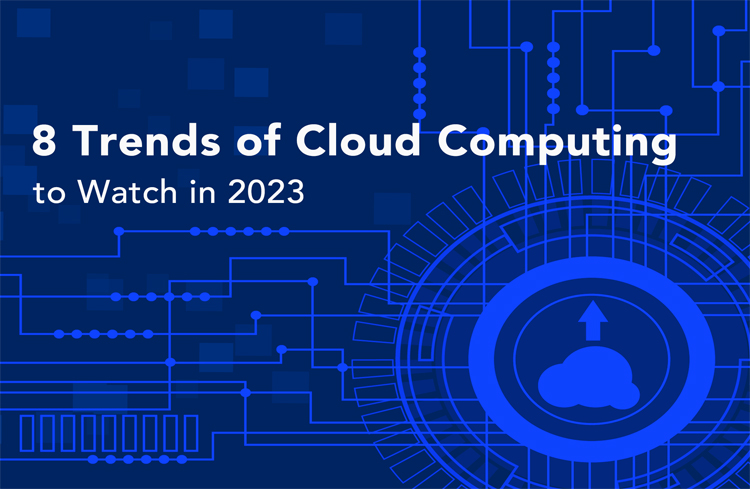
Cloud technology is the lifeline of the latest technological progress and a new-generation trendsetter in the modern tech industry. During the early days of the COVID-19 pandemic, companies worldwide began applying the work-from-home model to their global workforce and implementing various digital technologies into their businesses.
Another side effect of this new norm of remote working was the proliferation of cloud models. And, as organizations began adopting cloud models at a faster rate, the models themselves began evolving quickly too. Thus, cloud technology has expanded significantly over the last few years. Here are eight cloud computing trends which could influence the IT industry in 2023 and beyond:
1. Artificial Intelligence and Machine Learning
Most experts tout artificial intelligence and machine learning (AI and ML) as crucial technologies for the future of the business without realizing they need high bandwidth and processing capacity. An average business network doesn't have the resources to run AI/ML-based tools.
That's where cloud data centers come in. Cloud-based data centers enhance computation power and bandwidth to generate training data for machine learning platforms. By consequence, the integration of AI and ML into the cloud platform became highly necessary.
Cost savings is another major benefit of AI and ML cloud integration. Therefore, in 2023 and beyond, more powerful AI and ML solutions will function on cloud platforms.
2. Edge Computing
Edge computing is a distributed IT architecture that processes client data within the networks as close as possible to its source of origin. It provides swift, near-instant data processing with little to no latency and enhances data protection as the volume of transmitted data decreases.
The traditional computation model does not offer adequate security or efficiency for network infrastructure. Therefore, businesses are shifting their data and computing to the edge of their networks.
Bringing data processing, data collection, data storage and data analysis closer to the data source minimizes latency while also enabling the use of edge devices. Edge computing technology powers various smart devices (e.g., smartphones, smartwatches and smart cars) to work effortlessly nowadays.
3. Virtual Cloud Desktops
A virtual cloud desktop, also called desktop as a service (DaaS), is a cloud-based service that can transmit an entire desktop operating system and its software applications directly to a laptop, desktop or other device. Companies pay for the time their employees spend logged in to their devices.
4. Serverless Computing
Servers are still used in serverless computing. However, this cloud model makes it much simpler for businesses to access backend services without worrying about infrastructure management.
In serverless computing, cloud service providers charge users based on their usage of the cloud — and not based on a fixed number of servers or amount of bandwidth. As a result, businesses can focus more on their projects and products and less on their backend.
The serverless model is highly captivating and increasing in popularity among organizations. To stop wasting time and money on an outdated cloud model, business leaders should think about moving their cloud services to serverless in the future.
5. Automation
Automation is a vital cause of cloud adoption, improving companies' operational efficiency. Companies that merge their data and systems onto the cloud can automate their internal business processes. This will be ideal for those who want to work in an agile IT environment.
6. Hybrid Cloud
Some businesses today are favoring the hybrid cloud model, which integrates public cloud services with a private cloud dedicated to a single company. It is particularly suitable for companies that collect sensitive data or operate in highly regulated industries — such as insurance, where data privacy is most required.
7. Secure Access Service Edge (SASE)
Secure access service edge (SASE) is a cybersecurity concept that creates a secure link between applications/services and organizational elements like people, systems and devices.
Because of the digital transformation of businesses, security architecture is also getting transferred into the cloud. This is in part because the cloud provides considerable wide area network (WAN) capacity to support digital businesses across the world.
8. Cloud Disaster Recovery
Cloud disaster recovery (CDR) is a cloud-based solution that quickly restores an organization's critical systems in the event of a disaster and enables remote access to systems within secure virtual surroundings. It also merges various backup processes and services to protect resources like data, programs and configurations.
Cloud backups help companies restore any affected data and restart normal operations. Using traditional disaster recovery to manage a secondary data center can be time-consuming and expensive, but CDR is very pocket-friendly.
Conclusion
In 2023 and beyond, the cloud technology revolution will continue its rapid development. More and more companies and organizations will migrate their businesses to the cloud to find solutions to their business concerns.
Consequently, cloud technology will continue to evolve in the coming years too — and will likely play a pivotal role in reshaping the economy.
Source: https://www.techopedia.com/the-future-of-cloud-computing-8-trends-to-watch-in-2023/2/34849

